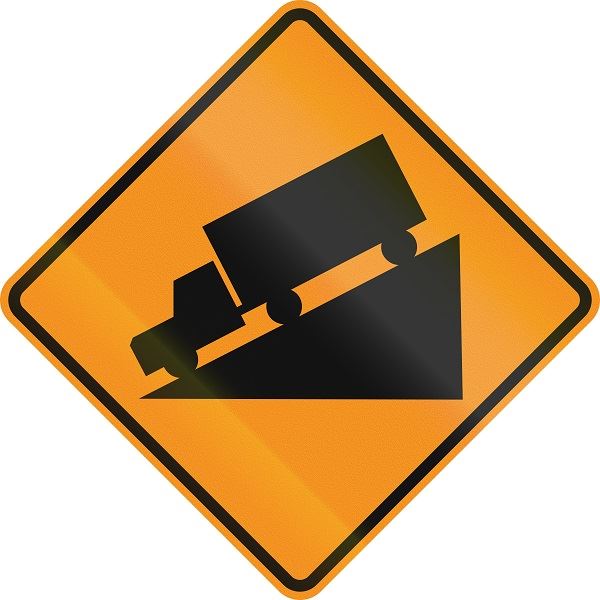 Truckers making deliveries in San Francisco would laugh at other truckers
talking about a 6% hill grade as if it were worrisome. Prentiss Street
between Powhattan Ave and Chapman has a hill grade greater than 37%, San
Francisco itself is a virtual roller-coaster for drivers. Even the street
with the most curves, the famous Lombard, has a 14% grade.
Truckers making deliveries in San Francisco would laugh at other truckers
talking about a 6% hill grade as if it were worrisome. Prentiss Street
between Powhattan Ave and Chapman has a hill grade greater than 37%, San
Francisco itself is a virtual roller-coaster for drivers. Even the street
with the most curves, the famous Lombard, has a 14% grade.
Did you know that an Interstate highway with a hill grade greater than 7% is out of standards for highways designed for use by tractor-trailers and requires a truck lane? The percentage of grade is more a discussion for highway designers than truckers. They study weight-to-power values in a variety of trucks, speed and distance plots, estimated performance for tractor-trailers in various classes and tandem configurations, such as doubles and triples to decide on an acceptable grade. A necessary question for discussion during the design of a highway is, at what grade does a truck’s loss of speed become worrisome enough to add a truck lane? A truck’s lost speed on higher hill grades leads to an increase in accidents. This also applies to vehicles towing recreational vehicles and buses.
Truckers know they must navigate those hills to deliver their load, end of discussion. They know how worrisome and irksome driving up and down a tricky 6% hill grade in California can be with a full load. For most, coming down one of these is more nerve-wracking than going up. But, there are tricks to doing both and maintaining your truck’s speed.
Going up a 6% Hill Grade
Until you become a veteran at this, going up a 6% grade can be a trying experience, particularly with a full load. The ability of hill-climbing for a truck depends on engine torque. The ascent It is not as harrowing as the descent, but it will require practice before it becomes second nature and maintaining your speed during those first few runs can be challenging. Some may want to practice with an empty truck out there in the San Gorgonio Pass and Coachella Valley in the Riverside and San Bernardino County areas, though there are many other places out in Inyo, Tulare, or Kern counties.
Going down a 6% Hill Grade
There is a state-wide 55 mph speed limit restriction as prescribed by California Vehicle Code (CVC) sections 22348-22406 for all vehicles towing a trailer and many buses, this also limits these vehicles to the “slow lane.” Unless a local authority decides that 55 mph is too fast for the hill grade, such as out there on I-15 through the Cajon Pass southbound, where it is posted 45 mph for truckers. There is further clarification on that in CVC 22407, which discusses “decreasing truck speed limit.” The code specifically discusses three axle vehicles and gross vehicle weight, so a two-axle bobtail is exempt from the reduced speed limit unless it exceeds the gross vehicle weight or is carrying explosive materials, though some inexperienced sheriff’s deputies may not see it that way and ticket you anyway.
As mentioned, going down is usually a lot more difficult and intimidating than going up. It used to be recommended that trucker drivers descend slowly while steadily applying the brakes, a method known as “controlled braking.” This was based on an outdated theory, though some older truckers still used this approach because that was what they were taught and it is still taught in some training center.
The new recommended method is “snub braking”: 1) Select the appropriate gear for the specific grade (this should be a lower gear), 2) allow the truck to speed up to a safe speed as it descends the hill, 3) apply the brake hard until it slows the truck in 5 mph intervals, and 4) repeat the cycle. Many manuals state that to understand how this works to keep all the brakes cool, you must comprehend a procedure for air brakes called, “pneumatic balance,” which evens the pounds-per-square-inch (psi) applied to all brakes.
Why You Need Not Fear the 6% Hill Grade
Although there are those truckers who are intimidated going down a 6% hill grade, most know it is simply a matter of applying the fundamentals in any road conditions. After a few times, it’s likely you will learn to navigate the hills of California by applying the fundamentals and adhering to the CVC.
In all that you do, keep an eye on the truck’s RPMs. And, always take road conditions, the terrain, and traffic conditions into account when determining a safe speed, no matter what the posted speed limit. You do all this and you’ll be right as rain driving that tractor-trailer up and down the hills of California.
If you were ticketed for what you believe to be an unjust ticket, “going too fast for conditions,” tailgating, or exceeding the posted speed limit give Bigger & Harman a call, 661-349-9300. We can also correspond by email attorney@markbigger.com. Scan a copy of your ticket and send it to us along with the details surrounding the ticket and we will reply as soon as possible with a recommended defense. There are many DMV processes, technicalities, and circumstances that could apply to your situation.
En español, llame al 661-349-9755.
